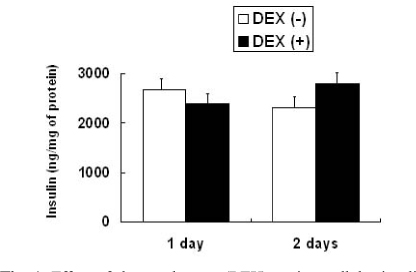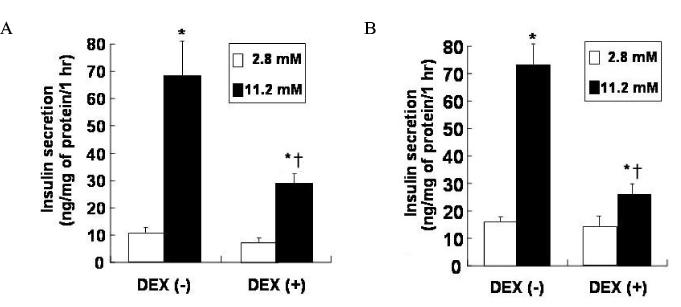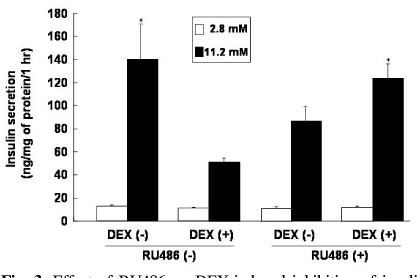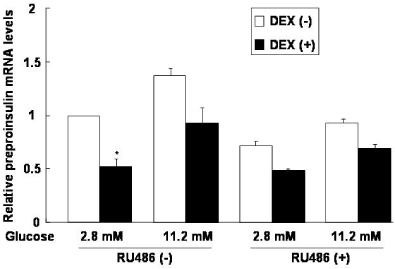J Korean Diabetes Assoc.
2006 Nov;30(6):428-434.
Role of Glucocorticoid Receptor on Insulin Secretion and Synthesis in INS-1 Cells
- Affiliations
-
- 1Department of Internal Medicine, College of Medicine, Dankook University, Korea.
Abstract
-
BACKGROUND: Glucocorticoids play important roles in the regulation of glucose homeostasis. It is well known that glucocorticoids reduce hepatic and peripheral tissue sensitivity to insulin, but the roles of glucocorticoids on insulin secretion and synthesis in pancreatic beta cells are still unclear. We have investigated the direct effects of glucocorticoids on insulin secretion and synthesis in rat insulinoma (INS-1) cells.
METHODS
Insulin content and 11.2 mM glucose-stimulated insulin secretion (GSIS) were measured in INS-1 cells after culture with or without 1 micrometer dexamethasone (DEX). Preproinsulin mRNA levels were analyzed by real-time RT-PCR and normalized to the internal control. Effect of RU486 on DEX-induced inhibition of GSIS and preproinsulin mRNA synthesis was evaluated.
RESULTS
Insulin content of INS-1 cells cultured in RPMI containing 11.2 mM glucose in the presence of DEX was not different from that of control cells. After 1-h preincubation in 2.8 mM glucose, basal insulin secretion from cells treated with DEX did not differ from that of controls, but GSIS was significantly reduced in the cells treated with DEX in comparison to control cells. The expression of preproinsulin mRNA relative to beta-actin mRNA was also lower in the cells treated with DEX. Glucocorticoid receptor antagonist improved DEX-induced inhibition of GSIS and preproinsulin mRNA synthesis.
CONCLUSION
DEX inhibited GSIS and preproinsulin mRNA synthesis in INS-1 cells. Glucocorticoid receptor antagonist ameliorated the reduced GSIS and preproinsulin mRNA synthesis induced by DEX.
Keyword
MeSH Terms
Figure
Reference
-
1. McMahon M, Gerich J, Rizza R. Effects of glucocorticoids on carbohydrate metabolism. Diabetes Metab Rev. 1988. 4:17–30.2. Hirsch IB, Paauw DS. Diabetes management in special situations. Endocrinol Metab Clin North Am. 1997. 26:631–645.3. Andrews RC, Walker BR. Glucocorticoids and insulin resistance: old hormones, new targets. Clin Sci. 1999. 96:513–523.4. Tappy L, Randin D, Vollenweider P, Vollenweider L, Paquot N, Scherrer U, Schneiter P, Nicod P, Jequier E. Mechanisms of dexamethasone-induced insulin resistance in healthy humans. J Clin Endocrinol Metab. 1994. 79:1063–1069.5. Coderre L, Srivastava AK, Chiasson JL. Effect of hypercorticism on regulation of skeletal muscle glycogen metabolism by insulin. Am J Physiol. 1992. 262:E427–E433.6. Owen OE, Cahill GF Jr. Metabolic effects of exogenous glucocorticoids in fasted man. J Clin Invest. 1973. 52:2596–2605.7. Hollingdal M, Juhl CB, Dall R, Sturis J, Veldhuis JD, Schmitz O, Porksen N. Glucocorticoid induced insulin resistance impairs basal but not glucose entrained high-frequency insulin pulsatility in humans. Diabetologia. 2002. 45:49–55.8. Wajngot A, Giacca A, Grill V, Vranic M, Efendic S. The diabetogenic effects of glucocorticoids are more pronounced in low- than in high-insulin responders. Proc Natl Acad Sci USA. 1992. 89:6035–6039.9. Henriksen JE, Alford F, Ward GM, Beck-Nielsen H. Risk and mechanism of dexamethasone-induced deterioration of glucose tolerance in non-diabetic first-degree relatives of NIDDM patients. Diabetologia. 1997. 40:1439–1448.10. Lambillotte C, Gilon P, Henquin JC. Direct Glucocorticoid Inhibition of Insulin Secretion-An In Vitro Study of Dexamethasone Effects in Mouse Islets. J Clin Invest. 1997. 99:414–423.11. Delaunay F, Khan A, Cintra A, Davani B, Ling ZC, Andersson A, Ostenson CG, Gustafsson J, Efendic S, Okret S. Pancreatic beta cells are important targets for the diabetogenic effects of glucocorticoids. J Clin Invest. 1997. 100:2094–2098.12. Jeong IK, Oh SH, Kim BJ, Chung JH, Min YK, Lee MS, Lee MK, Kim KW. The effects of dexamethasone on insulin release and biosynthesis are dependent on the dose and duration of treatment. Diabetes Res Clin Pract. 2001. 51:163–171.13. Asfari M, Janjic D, Meda P, Li G, Halban PA, Wollheim CB. Establishment of 2-mercaptoethanol-dependent differentiated insulin-secreting cell lines. Endocrinology. 1992. 130:167–178.14. Biering H, Knappe G, Gerl H, Lochs H. Prevalence of diabetes in acromegaly and Cushing syndrome. Acta Med Austriaca. 2000. 27:27–31.15. Boscaro M, Barzon L, Fallo F, Sonino N. Cushing's syndrome. Lancet. 2001. 357:783–791.16. Pagano G, Cavallo-Perin P, Cassader M, Bruno A, Ozzello A, Masciola P, Dall'omo AM, Imbimbo B. An in vivo and in vitro study of the mechanism of prednisone-induced insulin resistance in healthy subjects. J Clin Invest. 1983. 72:1814–1820.17. Stojanovska L, Rosella G, Proietto J. Dexamethasone-induced increase in the rate of appearance in plasma of gut-derived glucose following an oral glucose load in rats. Metabolism. 1991. 40:297–301.18. Karlsson S, Ostlund B, Myrsen-Axcrona U, Sundler F, Ahren B. Beta cell adaptation to dexamethasone-induced insulin resistance in rats involves increased glucose responsiveness but not glucose effectiveness. Pancreas. 2001. 22:148–156.19. Chuthaputti A, Fletcher HP. Effect of hydrocortisone on terbutaline stimulated insulin release from isolatedpancreatic islets. Res Commun Chem Pathol Pharmacol. 1987. 57:329–341.20. Brunstedt J, Nielsen JH. Direct long-term effect of hydrocortisone on insulin and glucagon release from mouse pancreatic islets in tissue culture. Acta Endocrinol. 1981. 96:498–504.21. Fernandez-Mejia C, Davidson MB. Regulation of glucokinase and proinsulin gene expression and insulin secretion in RIN-m5F cells by dexamethasone, retinoic acid, and thyroid hormone. Endocrinology. 1992. 130:1660–1668.22. Schoneveld OJ, Gaemers IC, Lamers WH. Mechanisms of glucocorticoid signalling. Biochim Biophys Acta. 2004. 1680:114–128.23. Zhou J, Cidlowski JA. The human glucocorticoid receptor: one gene, multiple proteins and diverse responses. Steroids. 2005. 70:407–417.24. Buttgereit F, Brand MD, Burmester GR. Equivalent doses and relative drug potencies for non-genomic glucocorticoid effects: a novel glucocorticoid hierarchy. Biochem Pharmacol. 1999. 58:363–368.25. Sitruk-Ware R, Spitz IM. Pharmacological properties of mifepristone: toxicology and safety in animal and human studies. Contraception. 2003. 68:409–420.26. Gremlich S, Roduit R, Thorens B. Dexamethasone induces posttranslational degradation of GLUT2 and inhibition of insulin secretion in isolated pancreatic beta cells. Comparison with the effects of fatty acids. J Biol Chem. 1997. 272:3216–3222.27. Shinozuka Y, Okada M, Oki T, Sagane K, Mizui Y, Tanaka I, Katayama K, Murakami-Murofushi K. Altered Expression of HES-1, BETA2/NeuroD, and PDX-1 Is Involved in Impaired Insulin Synthesis Induced by Glucocorticoids in HIT-T15 Cells. Biochem Biophys Res Commun. 2001. 287:229–235.
- Full Text Links
- Actions
-
Cited
- CITED
-
- Close
- Share
- Similar articles
-
- Resistin Inhibits Insulin Secretion Through Inhibition of Insulin Granule Docking Via Downregulation of Rab3A in Pancreatic Beta-cells
- A Portulaca oleracea L. extract promotes insulin secretion via a Kâº(ATP) channel dependent pathway in INS-1 pancreatic β-cells
- Red Liriope platyphylla stimulated the insulin secretion through the regulation of calcium concentration in rat insulinoma cells and animal models
- Glucagon-Like Peptide-1 Increases Mitochondrial Biogenesis and Function in INS-1 Rat Insulinoma Cells
- Ca(2+)-induced Ca2+ Release from Internal Stores in INS-1 Rat Insulinoma Cells





